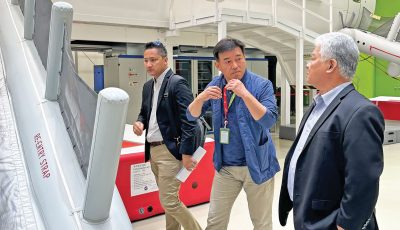Tsonggo
Unggoy is the common word for “monkey” in Tagalog. Growing up, we called the biped tsonggo, pronounced the same way as “Zhongguo,” China of the Middle Kingdom, and Zhongguoren, of its people.
I noticed the practice in U.S. political advertising to blame the Chinese for the flight of jobs to the cheap manufacturing factories of China. But education boards in some states now make the learning of the Chinese language an offering in school curriculum, and Chamber of Commerce officials poise their economies to attract Chinese investments.
My Ottawa seatmate on the plane to China led a team of software specialists to a database center a few miles outside Hoh Hot, Nei Menggu. He was there for a week to troubleshoot a current contradiction of an IT operation with a team of international talents including folks of Sino-descent. The locals are not swinging tsonggos; they are sophisticated folks engaged in complex tasks.
We shan’t rehearse the historical incidences of the Chinese Exclusion Acts both in the United States and Canada. What is clear is that the new “black” in our time is “yellow,” save they are lured rather than oppressed, and they are spending a fortune in boutique stores all over the world with enough to spare for the gold in Macau and Hong Kong, tolerated lot with open arms when they reach for their wallets. Acceptance into neighborhoods is another matter.
In Calgary, Alberta, two weeks ago, I was told of a ranking official raking new Chinese immigrants over the coals for being too obsessed with making money; also, that Bus No. 3 is called the Asian Express because starting at 10:30am, all the Chinese in the NW quadrant of the city head for Chinatown for their daily dimsum. This is, of course, an exaggeration but the stereotyping of the Chinese continues for as long as there are Chinatowns.
There is a major contradiction in the world’s treatment of the Chinese and how they abrasively present themselves to the world. Numbers indicate that out of every five people in the planet, one is Chinese. South Asia (Bangladesh, Pakistan, Sri Lanka, India) is projected to equal China’s total in a decade but the predominance of Sino dominance in Chinatowns around the world spells a difference in presence.
Allegiance to nation-state still predominates among citizens of China and India, but if there is anything that the democratic West promotes, if only in its pretensions, it is the value of the individual and the virtue of solitariness as the eventual nature of homo sapiens. There is reason why a fourth of Koreans are named Kim, but it would be a mistake to continue lumping them together by race and/or political affiliation without acknowledging the value of the individual.
The same holds true as we remember the first A-bomb over Hiroshima. We treat the event as an assault on a people rather than as a violation on 60,000 innocent individuals, recent in their newfound selfhood ironically started in an industrialized war in the trenches of World War I. What would it mean to read individually the names of 60,000 people that evaporated in a flash from flesh into atomic puffs not too long ago?
Would we do the same for the gas pipeline explosion a few months back in Shandong, China, that cost us more than a few lives, and more recently, in Kaohsiung, Taiwan? These were examples on how we had the cost of pipe laying trump safety of population as gas companies actually built pipelines along city sewage lines. After the landslides that buried folks in India and Nepal, the consequence of over-logging, we hear of a factory explosion in Jiangsu, China, that manufactures and polishes wheels for General Motors of the United States as one of its primary clients. Earthquakes have become more severe and frequent. South China in Yunnan and Guizhou just suffered unexpected loss of people and property. A disaster hits groups rather than individuals!
“Chinese and South Asians” of my acquaintance aspire to be treated as individuals rather than as members of their race. But the only means to individual recognition is by competition, along the ethos of getting ahead in society and the workplace. Classroom achievement in China is measured by competitive grading; students are treated as if they all have similar learning acumen determined by a common one-size-fits-all pedagogy.
I do not aspire to affect a large portion of the learning community. I am, however, convinced that whatever teaching I do, it is on imparting methods of learning on students’ initiative utilizing native skills rather than be awed learners “sitting at a master’s feet.”
I made sure my Canadian techie seatmate on the plane was clear he needed to train someone to replace him within a year. We push Zhongguo education toward a similar direction, for students to intentionally teach themselves to learn and teach, get peers to actually learn from and teach each other, and move a master pedagogue to disappear elsewhere each time an aim is reached as quickly as possible.



























